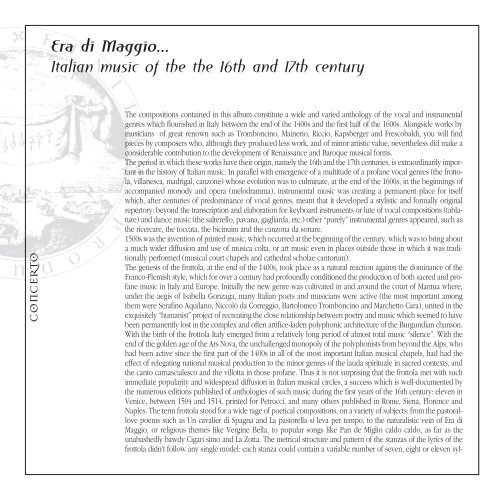Booklet (PDF 386 Kb) - Concerto Classics
Booklet (PDF 386 Kb) - Concerto Classics
Booklet (PDF 386 Kb) - Concerto Classics
You also want an ePaper? Increase the reach of your titles
YUMPU automatically turns print PDFs into web optimized ePapers that Google loves.
Era di Maggio...<br />
Italian music of the the 16th and 17th century<br />
The compositions contained in this album constitute a wide and varied anthology of the vocal and instrumental<br />
genres which flourished in Italy between the end of the 1400s and the first half of the 1600s. Alongside works by<br />
musicians of great renown such as Tromboncino, Mainerio, Riccio, Kapsberger and Frescobaldi, you will find<br />
pieces by composers who, although they produced less work, and of minor artistic value, nevertheless did make a<br />
considerable contribution to the development of Renaissance and Baroque musical forms.<br />
The period in which these works have their origin, namely the 16th and the 17th centuries, is extraordinarily important<br />
in the history of Italian music. In parallel with emergence of a multitude of a profane vocal genres (the frottola,<br />
villanesca, madrigal, canzone) whose evolution was to culminate, at the end of the 1600s, in the beginnings of<br />
accompanied monody and opera (melodramma), instrumental music was creating a permanent place for itself<br />
which, after centuries of predominance of vocal genres, meant that it developed a stylistic and formally original<br />
repertory: beyond the transcription and elaboration for keyboard instruments or lute of vocal compositions (tablature)<br />
and dance music (the salterello, pavana, gagliarda, etc.) other “purely” instrumental genres appeared, such as<br />
the ricercare, the toccata, the bicinuim and the canzona da sonare.<br />
1500s was the invention of printed music, which occurred at the beginning of the century, which was to bring about<br />
a much wider diffusion and use of musica colta, or art music even in places outside those in which it was traditionally<br />
performed (musical court chapels and cathedral scholae cantorum).<br />
The genesis of the frottola, at the end of the 1400s, took place as a natural reaction against the dominance of the<br />
Franco-Flemish style, which for over a century had profoundly conditioned the production of both sacred and profane<br />
music in Italy and Europe. Initially the new genre was cultivated in and around the court of Mantua where,<br />
under the aegis of Isabella Gonzaga, many Italian poets and musicians were active (the most important among<br />
them were Serafino Aquilano, Niccolò da Correggio, Bartolomeo Tromboncino and Marchetto Cara), united in the<br />
exquisitely “humanist” project of recreating the close relationship between poetry and music which seemed to have<br />
been permanently lost in the complex and often artifice-laden polyphonic architecture of the Burgundian chanson.<br />
With the birth of the frottola Italy emerged from a relatively long period of almost total music “silence”. With the<br />
end of the golden age of the Ars Nova, the unchallenged monopoly of the polyphonists from beyond the Alps, who<br />
had been active since the first part of the 1400s in all of the most important Italian musical chapels, had had the<br />
effect of relegating national musical production to the minor genres of the lauda spirituale in sacred contexts, and<br />
the canto carnascialesco and the villotta in those profane. Thus it is not surprising that the frottola met with such<br />
immediate popularity and widespread diffusion in Italian musical circles, a success which is well-documented by<br />
the numerous editions published of anthologies of such music during the first years of the 16th century: eleven in<br />
Venice, between 1504 and 1514, printed for Petrucci, and many others published in Rome, Siena, Florence and<br />
Naples. The term frottola stood for a wide rage of poetical compositions, on a variety of subjects: from the pastorallove<br />
poems such as Un cavalier di Spagna and La pastorella si leva per tempo, to the naturalistic vein of Era di<br />
Maggio, or religious themes like Vergine Bella, to popular songs like Pan de Miglio caldo caldo, as far as the<br />
unabashedly bawdy Cigari simo and La Zotta. The metrical structure and pattern of the stanzas of the lyrics of the<br />
frottola didn’t follow any single model: each stanza could contain a variable number of seven, eight or eleven syl-


